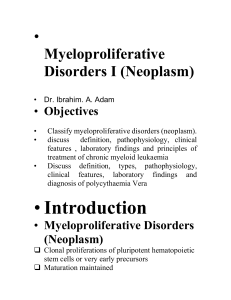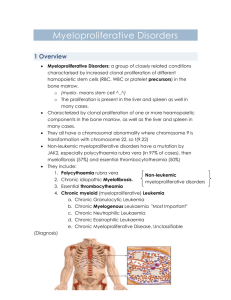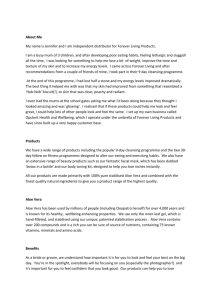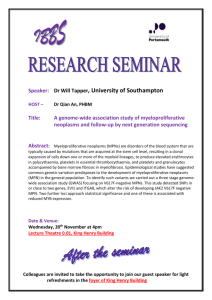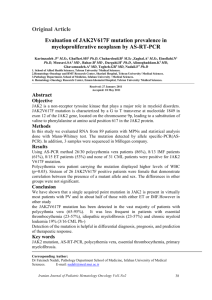Definition:
advertisement
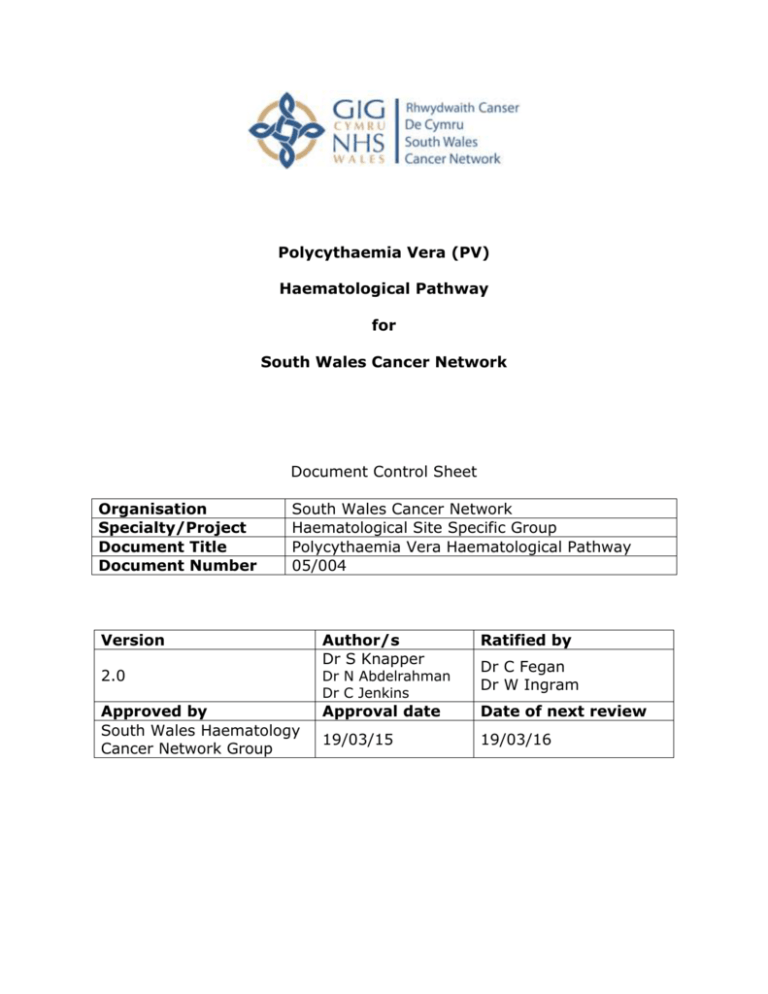
Polycythaemia Vera (PV) Haematological Pathway for South Wales Cancer Network Document Control Sheet Organisation Specialty/Project Document Title Document Number South Wales Cancer Network Haematological Site Specific Group Polycythaemia Vera Haematological Pathway 05/004 Version 2.0 Approved by South Wales Haematology Cancer Network Group Author/s Dr S Knapper Ratified by Approval date Date of next review 19/03/15 19/03/16 Dr N Abdelrahman Dr C Jenkins Dr C Fegan Dr W Ingram Polycythaemia Vera (PV) NSAG Patient Care Pathway Demographics - Estimated incidence of PV is 0.7-2.6 per 100,000 per year - Rises with age, median age for diagnosis is 60yrs. Slight male predominance (1-2:1) Diagnosis - Elevated haemoglobin / haematocrit has a wide differential diagnosis including: polycythaemia vera (PV) secondary causes of polycythaemia (eg.chronic hypoxia, EPOsecreting tumours) ‘apparent polycythaemia’ resulting from plasma depletion. - The threshold for investigation of individual patients will vary according to prior history of arterial or venous thrombosis, presence of thrombotic risk factors and associated symptoms. In general, patients with persistently raised haematocrit (>0.52 males, >0.48 females) should be investigated. Diagnostic tests - Initial screen: FBC, Blood film, JAK2 V617F PCR, ferritin, renal and liver biochemistry - If initial JAK2 mutation testing is negative and no obvious secondary cause is apparent, red cell mass / blood volume studies should be performed to confirm whether an absolute erythrocytosis (‘true polycythaemia’ is present). This investigation is currently available at University Hospital of Wales, Cardiff and Singleton Hospital, Swansea. - In JAK2 V617F negative patients in whom raised cell mass (>25% above predicted) is confirmed, the following tests are appropriate: Arterial blood gases Abdominal ultrasound Serum erythropoietin (EPO) level Bone marrow aspirate and trephine biopsy (including cytogenetic analysis) JAK2 exon 12 mutation screening (MF McMullin-Belfast or N CrossSalisbury) Polycythaemia Vera (PV) Pathway 1 BCSH diagnostic criteria for polycythaemia vera JAK2-Postitive Polycythaemia Vera: (A1 and A2 need to be present) A1: High haematocrit (>0.52 M, >0.48 F) OR raised red cell mass (>25% above predicted) A2: JAK2 mutation (V617F or exon 12) JAK2- Negative Polycythaemia Vera: (A1+A2+A3+either another A or two B criteria) A1: Raised red cell mass (>25% above predicted) OR haematocrit >0.60 M, >0.56 F) A2: Absence of mutation in JAK2 A3: No cause of secondary erythrocytosis A4: Palpable splenomegaly A5: Presence of acquired genetic abnormality (excluding BCR-ABL) in haematopoietic cells B1: Thrombocytosis (platelet count >450×109/l) B2: Neutrophil leucocytosis (neutrophil count > 10×109/l non-smokers; >12.5×109/l smokers) B3: Radiological evidence of splenomegaly B4: Low serum erythropoietin or endogenous erythroid colony formation Staging and Prognostication - There is no formal staging system in PV - High risk features: age>60 previous documented thrombosis, migraine, erythromelalgia ‘significant splenomegaly’ (>5cm palpable or symptomatic) platelet count >1000x109/l diabetes or hypertension requiring pharmacological therapy Information Required at MDT: -ICD10 v 4 morphology code (M9950/3) Treatment The aims of treatment of PV are to: reduce the risk of thrombosis and haemorrhage, minimize the risk of transformation to AML or myelofibrosis, and to manage disease-related symptoms and complications General measures for all patients: - Venesection to maintain the haematocrit at less than 0.45 - Aspirin (75 mg daily) for all patients unless contraindicated - Aggressive management of cardiovascular risk factors: hypertension, smoking, diabetes, cholesterol Polycythaemia Vera (PV) Pathway 2 Cytoreductive therapy: - Should be considered if : Poor tolerance of venesection Symptomatic or progressive splenomegaly Severe symptoms: weight loss,sweats, pruritus Thrombocytosis - For those requiring cytoreductive therapy the choice of agent will be influenced by age (and whether patient or partner contemplating pregnancy), side effect profile and potential leukaemogenicity. In general: <40 years old: first line interferon, second line hydroxycarbamide 40–75 years old: first line hydroxycarbamide, second line interferon >75 years old: first line hydroxycarbamide, second line 32P / intermittent low dose busulphan or pipobroman (addition of anagrelide may be considered for control of thrombocytosis) MAJIC study: High risk PV patients who are unable to tolerate hydroxycarbamide or in whom hydroxycarbamide is ineffective may be eligible for entry into MAJIC (a randomized comparison of the JAK inhibitor Ruxolitinib with ‘best alternative therapy’). For information contact Dr Steve Knapper. Monitoring - Regular haematology outpatient clinic follow-up to monitor full blood count, disease symptoms / complications and treatment toxicity. - Patients receiving anagrelide should be offered 3-yearly bone marrow trephine biopsy to monitor for early evidence of myelofibrotic transformation Discharge - PV patients will generally require lifelong haematology clinic follow-up References Guidelines for the diagnosis, investigation and management of polycythaemia/erythrocytosis McMullin MF et al. British Journal of Haematology 2005:130:174–195. Amendment to the guideline for diagnosis and investigation of polycythaemia/erythrocytosis. McMullin MF et al. British Journal of Haematology 2007:138:821–82 WHO Classification of tumours of haematopoietic and lymphoid tissues (edited by Swerdlow et al 2008.) Z:\ststorage2\South Wales Cancer Network\SWCN\Tumour Site\Haematological\Pathways\004 Polycythaemia_vera (2_2015).doc Polycythaemia Vera (PV) Pathway 3
